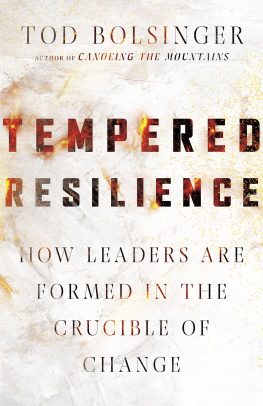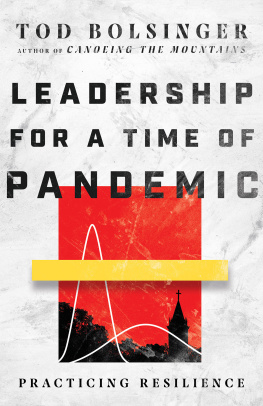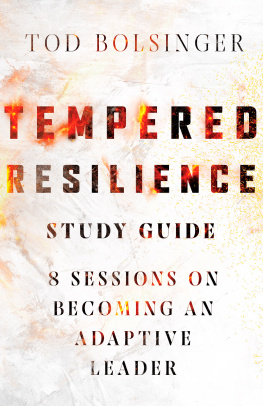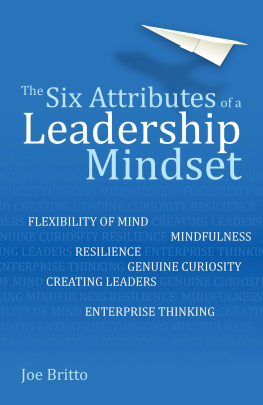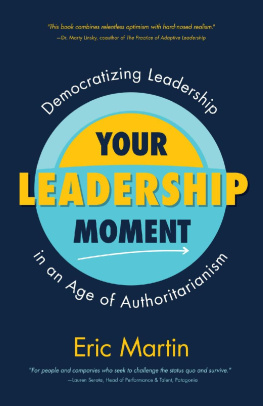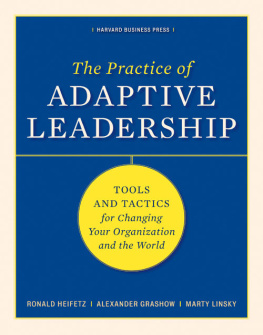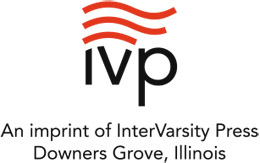Sommaire
Pagination de l'dition papier
Guide
Tod Bolsinger
How Leaders Are
Formed in the
Crucible of
Change
InterVarsity Press
P.O. Box 1400, Downers Grove, IL 60515-1426
ivpress.com
2020 by Tod E. Bolsinger
All rights reserved. No part of this book may be reproduced in any form without written permission from InterVarsity Press.
InterVarsity Pressis the book-publishing division of InterVarsity Christian Fellowship/USA, a movement of students and faculty active on campus at hundreds of universities, colleges, and schools of nursing in the United States of America, and a member movement of the International Fellowship of Evangelical Students. For information about local and regional activities, visit intervarsity.org.
Scripture quotations, unless otherwise noted, are from the New Revised Standard Version Bible, copyright 1989 National Council of the Churches of Christ in the United States of America. Used by permission. All rights reserved worldwide.
While any stories in this book are true, some names and identifying information may have been changed to protect the privacy of individuals.
Published in association with Creative Trust Literary Group LLC, 2006 Acklen Ave, PO Box 121705, Nashville, TN 37212-9998, www.creativetrust.com.
The publisher can't verify the accuracy of website hyperlinks beyond the date of print publication.
Cover design and image composite: David Fassett
Images: burst of glowing lines: Baac3nes / Moment Collection / Getty Images
bonfire sparks: Malorny / Moment Collection / Getty Images
ISBN 978-0-8308-4165-3 (digital)
ISBN 978-0-8308-4164-6 (print)
This digital document has been produced by Nord Compo.
To
Mark Roberts
for nearly four decades of
friendshipand formationin my life
Introduction
The Smiths Forge
They had become so focused on the aches and pains in the system that they had been thrown off course by the complaints. They had stopped supplying vision, or had burned out fighting the resistance; they had ceased to be the strength in the system. In short, they had forgotten to lead.
EDWIN FRIEDMAN
T HE QUESTION I FIND MYSELF ASKING is not Can I learn the skills I need to lead change? but rather Can I survive it?
The senior pastor of a large church spoke these words to me in a whisper. But I had become accustomed to hearing similar thoughts from leaders in different organizations and in vastly different contexts. In fact, these words repeated over and over again inspired everything you are about to read.
But let me start in two places that are a worldand twenty-five yearsapart.
In 1992, my wife and I traveled to Prague, Czech Republic. One day, near the end of our trip, Beth and I walked through Staromstsk nmst, a large central square. There in the middle of the square were two artisans who were drawing a sizable crowd to watch them ply their craft. They took pieces of scrap iron, discards, and by first heating them until they were soft and pliable, and then held securely on the anvil, they were pummeled and pounded into a new shape. The process repeated: fire, steel, sweat; heating, holding, forming; placed, pounded, and finally, plunged into water.
I watched those artisansso physical, so purposeful, so violent with hammer and inferno, so precise and exacting. They seemed a living icon of God. For we are the raw material, scraps of hardened, resisting steel. And they, the craftsmen, are so like God in precision and purpose, using the heat of challenges, the anvil of community, and the hammer of practices to transform us from raw material into something useful and beautiful.
Fast forward twenty-five years and travel from Prague to Los Angeles. Adams Forge is a blacksmithing community in an industrial neighborhood on the north side of the city. It is a place where urban dwellers can leave their cell phones in the glove compartment for a couple of hours and learn the art of transforming rods of steel into tools that can be used. What was once raw material becomes, under the hand of the smith and through the heat of the forge, a new creation that is both pure and mixed, with a new purpose but with nothing lost of its original makeup. Through an age-old process from a previous century, we find a glimpse of what must happen in our lives if we are going to be able to leadand thrivein leading.
In 2015, I published a book on leadership in a changing world. Since the book was published I have been working at a large theological seminary teaching leadership formation and serving as a senior administrator working on changing theological education. Because of the book and my role, I have spoken about leading change to well over one hundred different groups across the theological and church spectrum in the past five years, and I have heard comments like the senior pastors many times.
Whether it was speaking to a group of United Church of Christ leaders in a Knights of Columbus Hall in St. Louis, a large group of Lutheran ChurchMissouri Synod Christian educators in Phoenix, a select group of Episcopal priests in Manhattan, or Baptist pastors and lay leaders in Auckland, New Zealand; whether Methodists or Pentecostals, nondenominational leaders or seminary educators, over and over someoneusually the person in charge of training, education, or leadership developmentwould whisper to me, I dont think we have anyone who can actually do this. Indeed, one seminary president said to me, I dont think I can find anyone in the entire country to lead the kind of changes that you are talking about.
The question I find myself asking is not, Can I learn the skills I need to lead change? but rather Can I survive it?
The changes that I was describing call for adaptive leadership. And these leaders werent talking about the specific skills I was teaching. They were speaking about the stamina, the strength of purpose, the perseverance necessary to lead a church, institution, or organization through deep organizational change.
Why is this so difficult? Resistance. Internal resistance.
Resistance is the key difference between management and leadership: Good management is usually met with a grateful response from those whom we manage. Leadership is often met with stubborn resistance from the very people we are called to lead.
Management is about helping people get to where they want to go and accomplish what they want to accomplish. Management is about taking care of the most important assets, opportunities, resources, plans, and especially, as one of my colleagues often reminds us, of the people entrusted to our care. Management, biblically speaking, is called stewardship. And stewardship is about taking care of what is most valuable and accomplishing together what all of us most want to get done.
Whenever I am hiring a youth leader, I often joke that every parent actually wants a youth manager. If the youth leader takes ten kids to camp, they want all ten to be brought home safe and sound. As I tell my graduate students, the keyword here is all. Bringing home 90 percent is not an A in this case.
Humans are wired for stability and continuity, so we are deeply grateful for a good manager who keeps everything running well. But leading change is disruptive. And everything within us resists disruption. When we are faced with change, we need leaders who can stand it when we resist the very thing we want and need, even to the point where we will turn on them, oppose them, sabotage them. According to the late Edwin Friedman, one of the critical attributes of a leader who is going to bring about a renaissance or renewal of deep change is persistence in the face of resistance and downright rejection.

